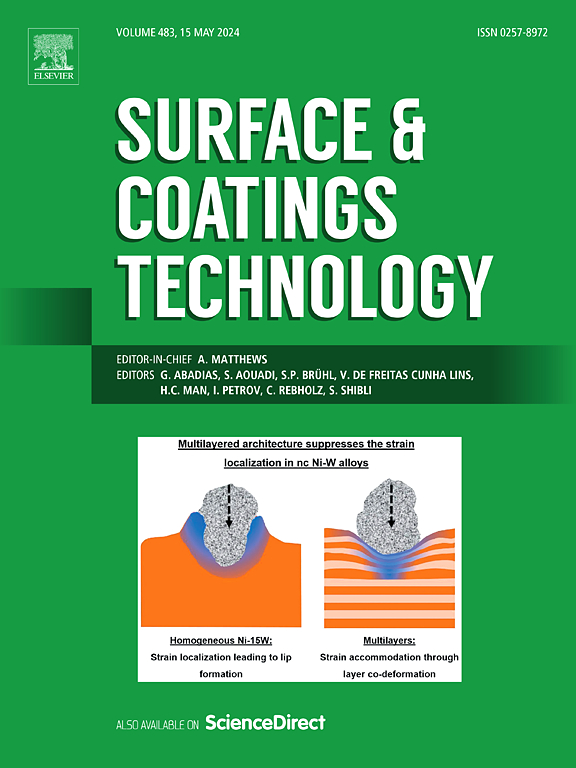磁控溅射制备超硬韧自润滑(TiZrHfNbTa)CxNy高熵碳氮化物薄膜
IF 5.3
2区 材料科学
Q1 MATERIALS SCIENCE, COATINGS & FILMS
引用次数: 0
摘要
传统的碳化物或氮化物薄膜具有良好的硬度和耐磨性,但缺乏理想的韧性。CN共掺高熵合金可获得良好的硬度-韧性组合。本研究采用反应磁控溅射法制备(TiZrHfNbTa)CxNy薄膜(HECN)。随着RN的增加,N含量上升至39at。%, C含量下降,稳定在25at .%。在RN = 6.5%和13%时,C/N和Me/(C + N)比值约为1:1。HECN薄膜从无定形向FCC纳米结晶转变,取向为(111)。在RN = 13%时,获得了39.9 GPa的超硬度和优异的断裂韧性(>1.92 MPa·m1/2)。由于摩擦诱导的c富集,膜具有自润滑性能,磨损率低(1.3 × 10-6 mm3/Nm),摩擦系数为0.15-0.2。本文章由计算机程序翻译,如有差异,请以英文原文为准。
Super-hard yet tough and self-lubricating (TiZrHfNbTa)CxNy high entropy carbonitride films deposited by magnetron sputtering
Traditional carbide or nitride films possess hardness and wear resistance but lack ideal toughness. C![]() N co-doped high-entropy alloys can achieve a good hardness-toughness combination. In this study, (TiZrHfNbTa)CxNy films (HECN) were deposited via reactive magnetron sputtering. With increasing RN, N content rose to 39 at.%, and C content decreased and stabilized at 25 at.%. At RN = 6.5 % and 13 %, C/N and Me/(C + N) ratios were approximately 1:1. HECN films transform from amorphous to FCC nano-crystallization with (111) orientation. At RN = 13 %, super-hardness of 39.9 GPa and excellent fracture toughness (>1.92 MPa·m1/2) was achieved. Due to tribo-induced C-enrichment, the film showed self-lubrication with a low wear rate (1.3 × 10-6 mm3/Nm) and a friction coefficient (0.15–0.2).
N co-doped high-entropy alloys can achieve a good hardness-toughness combination. In this study, (TiZrHfNbTa)CxNy films (HECN) were deposited via reactive magnetron sputtering. With increasing RN, N content rose to 39 at.%, and C content decreased and stabilized at 25 at.%. At RN = 6.5 % and 13 %, C/N and Me/(C + N) ratios were approximately 1:1. HECN films transform from amorphous to FCC nano-crystallization with (111) orientation. At RN = 13 %, super-hardness of 39.9 GPa and excellent fracture toughness (>1.92 MPa·m1/2) was achieved. Due to tribo-induced C-enrichment, the film showed self-lubrication with a low wear rate (1.3 × 10-6 mm3/Nm) and a friction coefficient (0.15–0.2).
求助全文
通过发布文献求助,成功后即可免费获取论文全文。
去求助
来源期刊

Surface & Coatings Technology
工程技术-材料科学:膜
CiteScore
10.00
自引率
11.10%
发文量
921
审稿时长
19 days
期刊介绍:
Surface and Coatings Technology is an international archival journal publishing scientific papers on significant developments in surface and interface engineering to modify and improve the surface properties of materials for protection in demanding contact conditions or aggressive environments, or for enhanced functional performance. Contributions range from original scientific articles concerned with fundamental and applied aspects of research or direct applications of metallic, inorganic, organic and composite coatings, to invited reviews of current technology in specific areas. Papers submitted to this journal are expected to be in line with the following aspects in processes, and properties/performance:
A. Processes: Physical and chemical vapour deposition techniques, thermal and plasma spraying, surface modification by directed energy techniques such as ion, electron and laser beams, thermo-chemical treatment, wet chemical and electrochemical processes such as plating, sol-gel coating, anodization, plasma electrolytic oxidation, etc., but excluding painting.
B. Properties/performance: friction performance, wear resistance (e.g., abrasion, erosion, fretting, etc), corrosion and oxidation resistance, thermal protection, diffusion resistance, hydrophilicity/hydrophobicity, and properties relevant to smart materials behaviour and enhanced multifunctional performance for environmental, energy and medical applications, but excluding device aspects.
 求助内容:
求助内容: 应助结果提醒方式:
应助结果提醒方式:


